Psoriasis is a non-communicable disease that affects a person's skin, nail plates and joints. The disease is characterized by a wavy course with periods of exacerbation and remission. The danger of this disease lies not only in the unpleasant feelings it causes, but also in the fact that the disease makes life very difficult, interferes with social adaptation and a normal quality of life. In severe cases, severe depression can result from an acute form of the disease.
How to get rid of psoriasis, what is it, what are the symptoms and treatment of psoriasis? You will learn about this in our article.
Pearl: causes
Under normal conditions, the skin of a healthy person is renewed within a month. During this time, the dead cells are removed and replaced with new ones. If there is a defect in the mechanism of skin renewal, the process of maturation of new cells takes only a week, which disrupts the cell balance. As a result, the cells die faster.
Excessive proliferation of cells of the immune system, macrophages and epithelial tissue is observed in the areas affected by the pathological process. Due to this, the skin is eroded and favorable conditions for the inflammatory process are created. In addition, the formation of new capillaries is accelerated, so the skin at the site of inflammation turns red.
Chronic psoriasis is non-infectious, so the disease is considered non-infectious. It was built in the 19th century, but scientists still do not know the exact reason for this.
Among the prerequisites for the development of the disease are:
- Heredity. If a person's parents or close relatives are prone to skin pathologies, it is more likely to be inherited. This is due to a mutation found in some parts of the DNA among patients suffering from psoriasis and a similar mutation in their loved ones.
- Gene mutations. Disorders in the structure of DNA, which affect the process of skin renewal, can not only be inherited, but also manifest themselves in later life in people whose relatives do not suffer from psoriasis. The causes of such genetic mutations are unknown.
- Weakening of the immune system. Any violation of the body's defenses can be a trigger for the development of psoriasis.
- Disorders of metabolic processes. Metabolic disorders in psoriasis manifest themselves in the form of changes in the metabolism of fat, nitrogen, carbohydrates and vitamins. As a result, the body accumulates toxins, decreases its ability to adapt and increases its susceptibility to infections. In addition, patients have an increase in the fractions of bile acids in the blood serum caused by metabolic diseases.
- External stimuli. Friction, constant contact with chemicals, wearing tight clothing, cuts and insect bites - all of these cause microtraumas on the skin, which can turn into psoriasis over time.
- Frequent allergic reactions. If a person's immune system is prone to atypical reactions, manifesting itself in the form of skin rashes, itching and rashes, this is an additional chance to get psoriasis.
- Intense experiences or long-term stressful situations. Any stress weakens the body's defenses and weakens the immune system. If a person is prone to skin diseases, it can manifest itself in these moments. In addition, any stress affects endocrine processes, due to which a significant amount of adrenaline and norepinephrine are released into the blood. This process affects metabolic processes and biochemical reactions, is a condition for the development of psoriasis.
- General weakness of the body caused by serious pathologies - atherosclerosis, cirrhosis of the liver, diabetes, hypertension, etc.
- An unbalanced diet and alcohol abuse. If a person eats very fatty, smoked, salty, sweet and spicy foods, the chances of developing psoriasis increase. In addition, in some cases, a prerequisite for the development of the disease is excessive consumption of chocolate and citrus fruits.
- Hormonal surges caused by significant changes in hormonal levels during menopause, puberty, pregnancy, lactation, abortion. It should be noted that the hormonal cause of psoriasis may not be related to the above periods. In this case, we are talking about changes in the functioning of the organs of the endocrine system.
- Climate change, living in unfavorable environmental conditions. If a person is prone to psoriasis and moves to a colder place, the disease can worsen significantly. The same applies to staying in areas with highly polluted air and water. However, the climatic factor can hardly be called the root cause of the disease: on the contrary, it acts as a catalyst that activates the "inactive" form of psoriasis in the body.
How to determine whether psoriasis: symptoms of the disease
First of all, psoriasis is a skin disease. However, in some, especially severe cases, it can affect not only the skin, but also the tendons, internal organs, spine, nail plates and joints. Below we will look at the symptoms of psoriasis that appear first and allow us to distinguish psoriasis from other skin pathologies.
How does psoriasis start?
On the surface of the skin (mostly on the knees, hands, elbows, back, armpits, under the chest, sacrum, genitals) and sometimes on the mucous membranes, round dry red areas appear. Initially, their size is relatively small: each papule is only a few millimeters in diameter. However, over time, the affected areas increase, the papules coalesce to form so-called psoriatic plaques: up to 10 cm in diameter and larger.
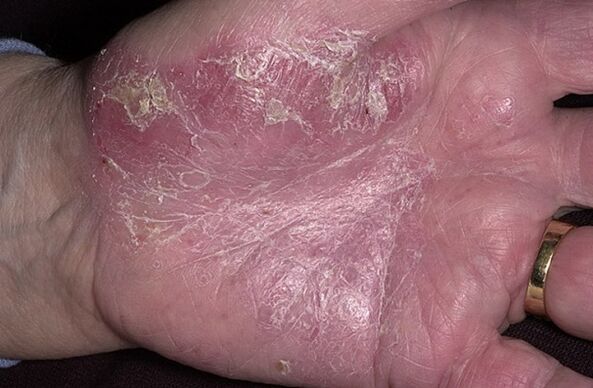
Initially, papules do not cause significant discomfort in a person. Practically no itching or itching. However, as you grow older and the plaque builds up, the affected areas thicken and rise slightly above the healthy areas of the skin. This phenomenon is accompanied by itching.
A characteristic feature of psoriasis in the early stages is the formation of small dry scales with a loose structure in the affected areas of the body. The color varies from whitish to yellowish-gray, and a thin pink-red edge appears around each plate. Externally, these zones are slightly melted paraffin, so they are called "paraffin lakes".
Initially, the symptoms of psoriasis on the body and face can be confused with the manifestations of eczema or other skin pathologies. The psoriasis stage - the so-called psoriasis trio - helps to accurately determine the type of disease.
- Stearic stain stage. It is characterized by the formation of characteristic stearin-like chips when the plate is broken.
- Terminal film stage. It looks like a smooth, moist and bright red surface found under the scales.
- "Blood shoulder" stage. When a person begins to break the terminal film, small drops of blood form on the surface, caused by precise bleeding. In turn, it causes thinning of the vascular network and capillary fragility.
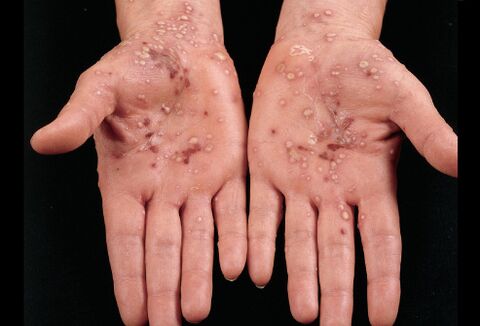
The onset of psoriasis is accompanied by non-skin symptoms. Patients generally complain of increased fatigue, apathy, irritability, drowsiness, mood swings, dizziness, nausea, and sleep problems.
How does psoriasis manifest itself other than skin lesions?
The disease affects not only the skin, but also other organs and systems. The following manifestations and forms of psoriasis differ:
- Psoriatic arthritis. In some cases, the lesion deepens rather than in the upper part of the skin. As a result, the disease spreads to the joints. The course of the disease is similar in many respects to the development of rheumatoid arthritis, but there are some differences between them. For example, in psoriatic arthritis, asymmetric joint damage is generally observed, the greatest concern being in the morning, but the main difference is the absence of rheumatoid factor in the blood of patients with psoriatic arthritis.
- Muscle damage. If the disease is at an advanced stage, muscle tissue atrophy may occur after cartilage and joint damage.
- Hepatic impairment. The liver's job is to cleanse the blood and remove harmful substances. If there is an increase in the amount of toxins in the body that are characteristic of psoriasis, the liver suffers first.
- Transmission of the disease from the skin to the mucous membrane. If left untreated, the disease progresses and spreads to the mucous membranes of the cheeks and genitals, lips and tongue. The mucous membranes swell, and inflammatory foci accompanied by desquamation appear.
- Damage to the nail plates (psoriatic onychodystrophy). Psoriasis nails are affected quite often. The disease manifests itself in the form of thickening of the nail plates on the hands and feet, discoloration, the appearance of grooves and dots on them. Inflammatory processes affecting the skin around the nails, bleeding under the nail plate, dryness, delamination and increased fragility of the nails can also be observed. Especially in severe cases, we can talk about the complete separation and loss of the nail.
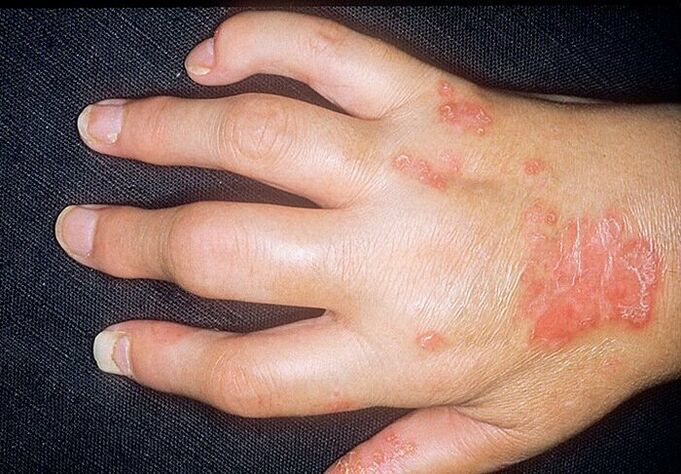
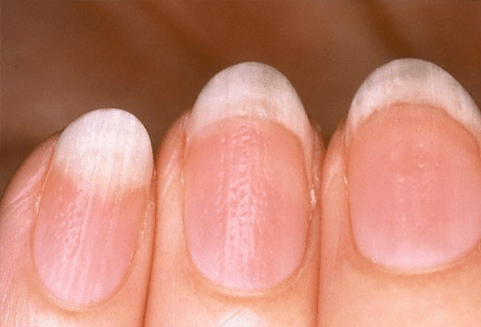
As you can see, this disease is very dangerous, so it is necessary to begin treatment as soon as possible to prevent its transmission to other organs and systems.
Is psoriasis contagious?
Because the disease is non-infectious and viral in nature, it is generally not contagious. The only way the disease is transmitted is through genetic predisposition.
Types of psoriasis
There are several types of this disease, each with its own course and characteristics.
- Simple / vulgar / plaque / plaque / common. According to the International Classification of Diseases - prosiasis vulgaris. This form is more common than others: in about 80-90% of cases, it is associated with psoriasis vulgaris. It is characterized by the appearance of "paraffin lakes" or psoriatic plaques.
- Reverse (reverse psoriasis). This type of disease mainly affects the skin wrinkles, the outer surface of the thighs, external genitalia and groin area. The main difference between reverse psoriasis and vulgar psoriasis is the absence of plaques on the skin with the reverse form of the disease: the skin is covered with red spots accompanied by an inflammatory process. The danger of reverse psoriasis is that it progresses with sweat and friction. Therefore, micro-cracks appear on the skin where the infection enters. As a result, it can cause skin lesions with cocci and fungi.
- In the form of drops (according to the ICD - guttate psoriasis). The difference from other types is that psoriatic rashes in the form of tears do not attach to large plaques. The patient's body is covered with small spots resembling drops that change color from pink to purple (hence the name of the disease).
- Pustular / exudative. While other types of the disease are characterized by dry areas of the skin, pustular or exudative psoriasis is characterized by weeping blisters filled with a clear liquid. In this condition, the skin around the blisters usually turns red, and the local temperature rises. If the bubbles burst or the patient combs them, there is a risk of infection and subsequent mammary gland - this is the main danger of the pustular form of the disease.
- Psoriatic erythroderma. This is one of the most severe forms of the disease, which can lead to the death of the patient if the course is unfavorable. A distinctive feature is the erosion of the skin, which can occur as a result of infection with pathogenic microflora. The first sign and symptom of this type of disease - psoriasis manifests itself in the form of severe itching of the skin, small red rashes with white scales, enlarged lymph nodes, swelling of the tissues and an increase in total body temperature to 38-39 degrees. . It is divided into generalized and hyperergic types.
- Seborrheic psoriasis. Most often, this type of disease affects the scalp, but in some cases it can involve the nasolabial folds, the skin near the ears, and the shoulder blades. The appearance of dandruff (when localized on the head) is characterized by intense itching and a grayish bloom.
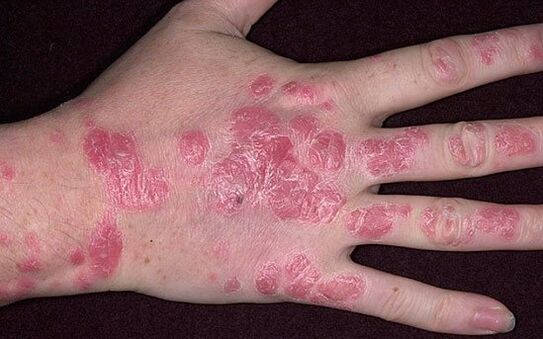
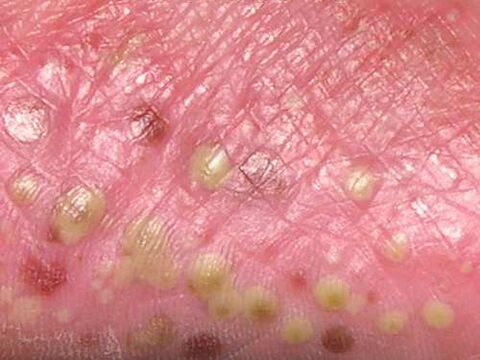
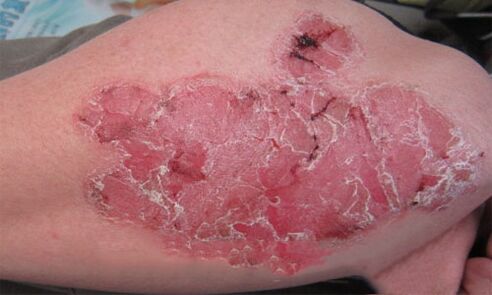


Exacerbation of psoriasis
The disease is characterized by a chronic wavy course with periods of exacerbation and remission. The decrease in the intensity of symptoms is usually observed in the hot season, the disease worsens in winter and autumn.
Factors that may exacerbate the disease may include:
- Stress, anxiety.
- Unbalanced work and rest schedule.
- Weakening of the body after an infectious or viral disease.
- A sharp jump in hormones.
- Take some medication.
- Use of inappropriate cosmetics.
- Skin contact with household chemicals.
- Dysfunction of organ systems.
- Exposure to excessively dry, hot or cold air.
- Strong personal hygiene is not provided.
- Insect bites.
- Exacerbation of allergic reactions.
- Wear tight synthetic clothing.
- Transition to an unusual climate.
Exacerbation of any skin disease (including psoriasis) is of great concern to the patient - not only physically, but also more psychologically. In the acute stage, the quality of life of a person suffering from severe psoriasis is significantly reduced.
Psoriasis patients often experience significant difficulties and problems with social adjustment that can negatively affect work / school / personal life. One person refuses to communicate with others and prefers to spend most of his time alone. As a result, social anxiety develops, which can turn into severe depression over time.
Exacerbation of the disease can make it difficult for the patient to care for himself and his loved ones, to lead a normal life and even to sleep. If the rash is localized in the genital area, it can cause physical and psychological discomfort and lead to rejection of intimacy by partners.
The severity of the disease
Mild, moderate, and severe forms of the disease spread to the affected area of skin and to the spread of the lesion to the joints, nails, and internal organs.
- The mild form involves a small amount of damage to the skin when the total area of the lesion is about 3%.
- Between 3% and 10% of human skin is considered moderately severe.
- Severe refers to a significant skin lesion of 10% or more of the total area of the skin.
If a patient is diagnosed with damage to the joints, muscles and internal organs, we are talking about a severe form of the disease, although there are practically no plaques and papules on the body.
How to get rid of psoriasis: treatment
The question of how to treat psoriasis forever worries all people suffering from this disease. The fight against the external manifestations of the disease gives only a temporary result, so it is important to eliminate the causes of psoriasis so that the effect is long-lasting. This usually takes a long time - up to a few years. The patient must be patient, but only in this case can rely on a long-term effect.
Below we look at how to treat psoriasis with medication, hormone therapy, phototherapy, exercise. We also refer to folk remedies for psoriasis - traditional medicine in combination with traditional therapy can give noticeable results.
Drug treatment of psoriasis
The first thing to do after detecting suspicious round rashes, increased dryness and peeling of the skin in yourself or your loved ones is to consult a qualified doctor. Only a dermatologist can determine exactly what type of skin damage is in your specific condition. Remember: under no circumstances should you treat yourself, as the lack of therapy or medications of your choice can seriously damage your health.
Tests and skin tests are generally not needed to diagnose the disease. To determine the cause of the damage, it is enough for the doctor to see the skin covered with papules or plaques. If there is a severe form of the disease, the dermatologist may prescribe an application for tests - general and biochemical studies of blood and urine, and skin biopsy, especially in difficult cases may be required. X-rays may also be needed to diagnose psoriatic arthritis.
There are several effective treatments for psoriasis. The choice of appropriate therapy depends on the degree of damage to the skin, joints, nails and the intensity of the disease. In general, the best option is to choose a comprehensive treatment regimen that includes the use of local and internal medications, the use of ultraviolet radiation, bathing in salt and soda baths, and physical therapy.
Creams, gels, ointments, sprays and lotions are used to relieve itching and breakage of damaged skin. They can be prepared on the basis of salicylic acid, pyrithione, resin and other active ingredients. The main task of hormonal and non-hormonal external preparations is to soften, disinfect psoriasis plaques, eliminate inflammation, moisturize and nourish the affected skin areas.
The role of oral drugs in the treatment of psoriasis in humans includes efalizubam, gamma-D-glutamyl-D-tryptophan sodium, etc.
A positive result in the treatment of psoriasis of the skin gives rest at sea. At the same time, it is advisable to choose resorts with a relatively mild and warm climate. The ideal solution is treatment in specialized sanatoriums and resorts, the rest of which is aimed at the complex therapy of psoriasis.
Pearl: home treatment
Treatment of psoriasis with home and folk remedies can be effective only if it plays the role of an adjunctive therapy that complements the main drug treatment. In addition, if the patient has an allergic reaction to drugs, a bet on traditional medicine can be made. But in any case, what to do with psoriasis should be decided by a doctor, so if you want to use this or that folk remedy, be sure to consult a dermatologist.
One of the most common traditional medicines for psoriasis is the use of baking soda. Sodium bicarbonate has a softening effect on psoriasis boards, softens rough skin, reduces itching and improves waste clearance. Homemade ointments and baths are made on the basis of soda, soda is taken orally, compresses and lotions are prepared.
In addition, salt baths are an effective way to treat the disease. If the patient does not have the opportunity to travel to the sea, they become a decent alternative.
The kernel water applied to psoriatic plaques also gives positive results. However, you should not forget that this tool is quite aggressive, so you need to make sure that the water does not fall on healthy areas of the skin.
Walnut shells are also used to fight psoriasis. The shell is poured with boiling water, then insist, the resulting infusion is filtered and added to a hot bath. This tool is especially effective during the outbreak of the disease.
How to treat psoriasis with diet?
Adequate nutrition plays an important role in all skin diseases, and psoriasis is no exception. Of course, a balanced diet can not be a hundred percent cure for psoriasis, but it works well in combination with medication and traditional medicine.
During treatment and to prolong remission, doctors recommend avoiding alcohol, smoked and salty foods, fatty and spicy foods, artificial flavors, preservatives, emulsifiers and chemical dyes, fatty meats, mayonnaise, ketchup. It is also advisable to reduce the amount of salt, sugar, chocolate and other sweets and citrus consumed. Doctors recommend paying attention to the use of low-fat fermented dairy products, plant foods, grains, lean meats and fish.
Although it is desirable to reduce the amount of fat consumed during the diet, it is unwise to give them up completely. You should replace animal fat with vegetable oils - olive, flax, corn, sunflower.
Prevention of psoriasis
The stages of psoriasis treatment necessarily include a period of remission. It is important to extend these periods as much as possible. To do this, the patient must follow the rules of prevention of a number of diseases:
- Avoid stressful situations.
- Eat a balanced diet.
- Avoid wearing tight clothing made of wool and synthetic materials.
- Spend enough time outdoors.
- Get enough rest and enough sleep.
- Take good care of your skin.























